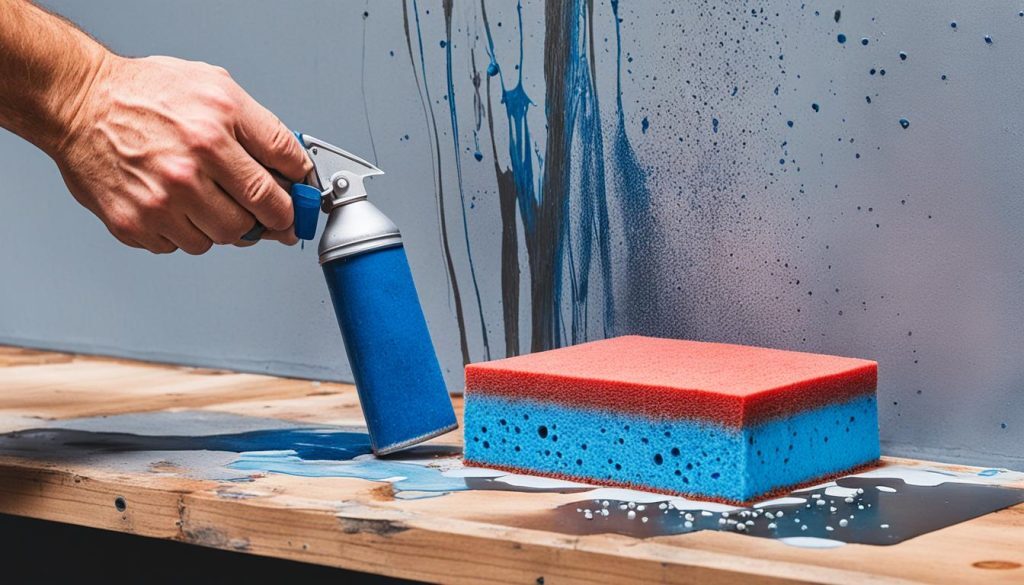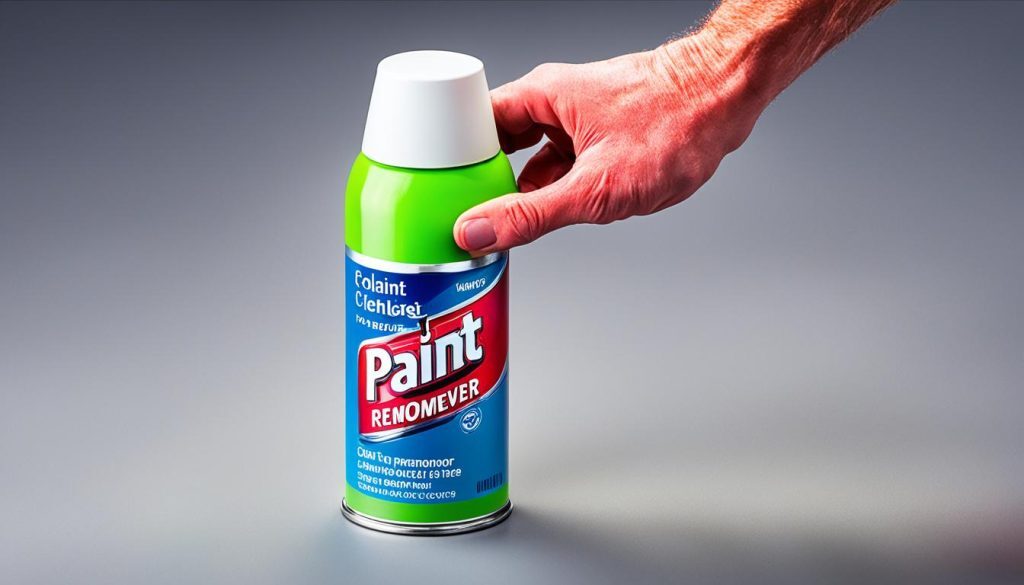Did you know that spray paint is responsible for over 50% of graffiti vandalism? It’s a staggering statistic that highlights the widespread impact of spray paint misuse. Whether it’s unwanted markings on public spaces or accidental overspray on personal belongings, the need to remove spray paint has become increasingly important.
In this effortless guide, I will share with you foolproof methods to remove spray paint from a variety of surfaces. Whether you’re dealing with metal, wood, concrete, plastic, glass, or even your own skin, I’ve got you covered with the most effective tips and techniques.
Key Takeaways:
- Spray paint is the primary medium used in over 50% of graffiti vandalism cases.
- This guide will provide easy and effective methods to remove spray paint from various surfaces.
- From metal to wood, concrete to plastic, and glass to skin, you’ll learn how to restore surfaces to their original condition.
- By following the right techniques and using appropriate materials, you can effectively remove spray paint and reclaim your surfaces.
- Prioritizing surface protection before spray painting can prevent the need for paint removal.
Prepare for Paint Removal
Before you embark on the process of removing spray paint, it’s crucial to be well-prepared and gather the necessary materials. Proper preparation ensures that you have everything you need to effectively remove the paint and achieve the desired results. Here are some essential steps to take:
- Identify the surface: Start by determining the type of surface you’ll be working on, whether it’s metal, wood, concrete, or another material. Different surfaces may require specific techniques and products for paint removal.
- Personal protective wear: To ensure your safety during the paint removal process, wear appropriate personal protective equipment such as gloves and masks. This protects your skin, eyes, and respiratory system from any potential harm caused by the chemicals or dust involved.
- Essential tools: Gather the necessary tools, including paint strippers, solvents, putty knives, and cleaning rags. These tools will help you effectively remove the spray paint from the surface without causing any damage.
In the case of removing paint from metal surfaces, it may be necessary to scrape off excess paint using a putty knife or scraper before applying a paint stripper or solvent. This helps to create a smoother surface for the subsequent paint removal process.
By properly preparing yourself and having the right materials at hand, you can embark on the spray paint removal process with confidence and achieve successful results. The next section will delve into the step-by-step techniques for removing spray paint from different surfaces.
Removing Spray Paint from Different Surfaces
Now let’s dive into the step-by-step process of removing spray paint from different surfaces. Whether you’re dealing with wood, concrete, plastic, or glass, there are effective DIY paint removal methods available.
Removing Paint from Wood
When removing spray paint from wood surfaces, it’s important to avoid scraping the surface to prevent damage. Instead, opt for a chemical paint remover specifically formulated for wood. Apply the paint remover according to the manufacturer’s instructions and allow it to sit for the recommended amount of time. Then, use a putty knife or soft-bristle brush to gently lift off the softened paint. For unfinished wood, sanding can also be an effective method to remove paint.
Removing Paint from Concrete
To remove spray paint from concrete surfaces, start by cleaning the area with warm water and a power or pressure washer. This will help remove any loose paint particles. Once the surface is clean and dry, apply a chemical paint stripper or thinner specifically designed for concrete. Follow the instructions on the product packaging and allow the stripper to penetrate the paint. Use a brush or pressure washer to further remove the paint, then rinse the area with clean water.
Removing Paint from Plastic
When it comes to removing spray paint from plastic surfaces, there are a few effective methods you can try. One option is to use rubbing alcohol or non-acetone nail polish remover. Apply a small amount to a clean cloth and gently rub the paint until it starts to dissolve. Another option is to create a paste using baking soda and water. Apply the paste to the painted surface and let it sit for a few minutes before scrubbing with a soft brush or cloth.
Removing Paint from Glass
Removing spray paint from glass surfaces is relatively straightforward. Start by cleaning the glass with dish soap, glass cleaner, or a vinegar-water solution. Use a soft cloth or sponge to gently scrub the painted area, focusing on any stubborn spots. Rinse the glass thoroughly with clean water to remove any residue. If needed, repeat the process until the paint is completely removed.
Remember to always follow safety guidelines and use appropriate protective gear when removing spray paint from any surface. Test any products in a small, inconspicuous area before applying them to the entire surface.

| Surface Type | Recommended Methods |
|---|---|
| Wood | Chemical paint remover or sanding |
| Concrete | Cleaning, chemical paint stripper or thinner |
| Plastic | Rubbing alcohol, non-acetone nail polish remover, or baking soda paste |
| Glass | Dish soap, glass cleaner, or vinegar-water solution |
Surface Protection Tips
To avoid the hassle of removing spray paint from unwanted areas, it’s important to take proper precautions and use surface protection products. Before you start spray painting, clear the area of any valuable items, cover nearby surfaces with drop cloths or plastic sheeting, and remove objects that you don’t want to get accidentally painted. You can also create a spray booth to contain overspray by working in a well-ventilated area and wearing appropriate protective gear. Additionally, masking and taping are crucial for precise and clean paint lines, so use painter’s tape to cover edges and borders.

| Surface Protection Products | Features |
|---|---|
| Spray Paint Shield | Protects adjacent surfaces from overspray |
| Drop Cloths | Covers and shields floors and furniture |
| Plastic Sheeting | Provides complete coverage for larger areas |
| Painter’s Tape | Helps create clean and precise paint lines |
| Protective Gear | Personal protection against paint particles and fumes |
Restored and Renewed Surfaces
By following the proper techniques and using the right materials, you can effectively remove spray paint and restore your surfaces to their original condition. It’s important to test any products in a small area, work in a well-ventilated space, and wear appropriate protective gear throughout the process.
Whether you’re removing spray paint from metal, wood, concrete, plastic, or glass, these methods have been proven to be effective. For metal surfaces, consider using a paint stripper or solvent to dissolve the paint and then scrape it off with a putty knife. For wood surfaces, sanding or using a chemical paint remover designed for wood can help restore its natural beauty. Concrete surfaces can be cleaned with a power washer and then treated with a chemical paint stripper or thinner. Plastic surfaces can be cleaned using household items like rubbing alcohol or non-acetone nail polish remover. And for glass surfaces, simple solutions like dish soap or vinegar-water mixtures can do the trick.
Once the paint has been removed and your surfaces are restored, it’s important to take steps to prevent future damage. Consider using surface protectors like drop cloths or plastic sheeting when spray painting, and make sure to cover any items or areas that you don’t want to accidentally paint. Creating a spray booth in a well-ventilated area can also help contain overspray. And when it comes to cleanup, using surface protectors and following the manufacturer’s instructions for paint strippers and solvents can make the process quick and easy.
